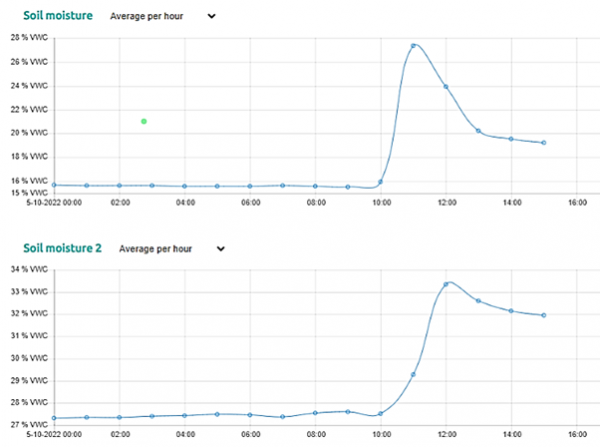What can sensors tell us about on-farm operations and how to help us improve efficiency?
Sensors can provide insights into a range of variables on the farm – so we can see what’s happening in real time. There are many sensors available now to help farms to monitor different aspects of the environment and operations, leading to informed decision making and in time, automation.
The amount of data available is substantial – sensors are able to provide constant data and so the key is converting data into useful information or actions at a number of levels:
- At the simplest level, regularly checking data will help to become more familiar with different aspects of the farm and understand patterns and how different variables respond to various inputs.
- Applications or dashboards allow more comprehensive analysis and setting parameters for alarms and alerts, and to compare data sets side by side to consider any relationships or correlations. This can include simple “traffic light” displays which indicate whether data is within a set range.
- Artificial intelligence or machine learning allow the data to be analysed to look for patterns that may not be detectable which may include predicting outcomes and events based on observed patterns.
- Automation where the system can take actions based on parameters set by the operator or learned by machine learning.
In our partnership with NNNCo and Enzen an NNNCo LorRaWAN network has been installed at two complex farms involving a LoRaWAN Gateway and over 50 sensors in southeast Queensland to monitor a range of parameters.
Some of the sensors we have installed on farm include:
- Energy monitoring of pumps, motors and key parts of the farms, including comparing energy consumption of similar systems on-farm to check on utilisation and efficiency.
- Silo fill levels for proactive inventory management.
- Humidity and Temperature Sensors in both intensive animal environments and in fields of frost-sensitive crops.
- Water tank levels.
- Vibration sensors on (a) pumps for preventative maintenance and (b) remote diesel-operated appliances to check if they are operating.
- Water quality sensors in dams to check for a range of indicators including pH, biogas production, Chlorine and Sodium.
- Plant sensors – with stem diameter and sap flow to test plant growth and stress.
- Leaf wetness sensors testing for moisture on leaf surfaces, monitoring frost threat and understanding the impact of humidity.
- Soil moisture probes at a range of depths.
- Geotracking of livestock and farm vehicles.
- Gate sensors to tell whether gates are open or closed.

Image: Data feed from Soil Moisture levels at 15cm and 30cm depth at the same location.
There are two next steps:
- Data Analysis: we’ll do a big data analysis to tell us about any trends or correlations between data set that simple observation on screen can’t tell us. We’ll have computers and analysts crunch the numbers to tell us.
- Actionable: how do we turn the extraordinary amount of data into simple actions, such as:
- combining wind speed, humidity and weather forecast to give us a green light or red light for spraying
- combining soil moisture, rainfall and weather forecast data to advise when irrigation may be required
Read also how Greenlife Industry Australia are using sensor data to find out about nutrient movement in nurseries and to help farm managers make decisions about irrigating to suit predicted weather conditions over the next few days.
QFF has teamed up with Enzen Australia (Enzen) and National Narrowband Network Company (NNNCo) to implement a Low Power, Wide Area (LoRaWAN) network technology on two farms in Queensland and create an IoT solution to cover the end-to-end operations of the properties.
Read an earlier article about the project HERE.
This Project has received funding from the Queensland Government through the Agribusiness Digital Solution Grants Program 2021